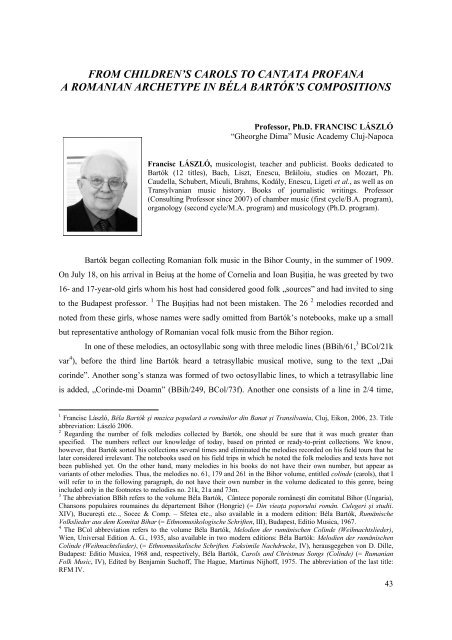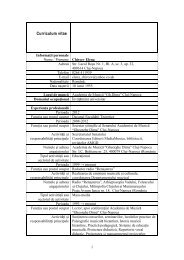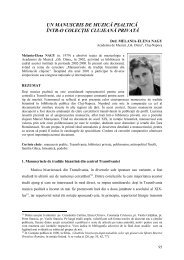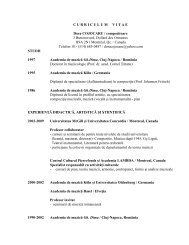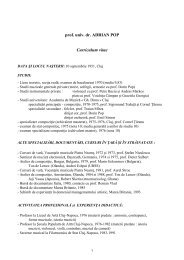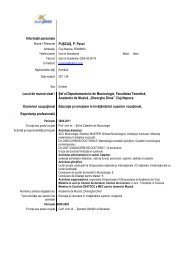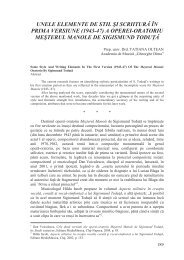Create successful ePaper yourself
Turn your PDF publications into a flip-book with our unique Google optimized e-Paper software.
FROM CHILDREN’S CAROLS TO CANTATA PROFANA<br />
A ROMANIAN ARCHETYPE IN BÉLA BARTÓK’S COMPOSITIONS<br />
Professor, Ph.D. FRANCISC LÁSZLÓ<br />
“Gheorghe Dima” Music Academy Cluj-Napoca<br />
Francisc LÁSZLÓ, musicologist, teacher and publicist. Books dedicated to<br />
Bartók (12 titles), Bach, Liszt, Enescu, Br�iloiu, studies on Mozart, Ph.<br />
Caudella, Schubert, Miculi, Brahms, Kodály, Enescu, Ligeti et al., as well as on<br />
Transylvanian music history. Books of journalistic writings. Professor<br />
(Consulting Professor since 2007) of chamber music (first cycle/B.A. program),<br />
organology (second cycle/M.A. program) and musicology (Ph.D. program).<br />
Bartók began collecting Romanian folk music in the Bihor County, in the summer of 1909.<br />
On July 18, on his arrival in Beiu� at the home of Cornelia and Ioan Bu�i�ia, he was greeted by two<br />
16- and 17-year-old girls whom his host had considered good folk „sources” and had invited to sing<br />
to the Budapest professor. 1 The Bu�i�ias had not been mistaken. The 26 2 melodies recorded and<br />
noted from these girls, whose names were sadly omitted from Bartók’s notebooks, make up a small<br />
but representative anthology of Romanian vocal folk music from the Bihor region.<br />
In one of these melodies, an octosyllabic song with three melodic lines (BBih/61, 3 BCol/21k<br />
var 4 ), before the third line Bartók heard a tetrasyllabic musical motive, sung to the text „Dai<br />
corinde”. Another song’s stanza was formed of two octosyllabic lines, to which a tetrasyllabic line<br />
is added, „Corinde-mi Doamn” (BBih/249, BCol/73f). Another one consists of a line in 2/4 time,<br />
1<br />
Francisc László, Béla Bartók �i muzica popular� a românilor din Banat �i Transilvania, Cluj, Eikon, 2006, 23. Title<br />
abbreviation: László 2006.<br />
2<br />
Regarding the number of folk melodies collected by Bartók, one should be sure that it was much greater than<br />
specified. The numbers reflect our knowledge of today, based on printed or ready-to-print collections. We know,<br />
however, that Bartók sorted his collections several times and eliminated the melodies recorded on his field tours that he<br />
later considered irrelevant. The notebooks used on his field trips in which he noted the folk melodies and texts have not<br />
been published yet. On the other hand, many melodies in his books do not have their own number, but appear as<br />
variants of other melodies. Thus, the melodies no. 61, 179 and 261 in the Bihor volume, entitled colinde (carols), that I<br />
will refer to in the following paragraph, do not have their own number in the volume dedicated to this genre, being<br />
included only in the footnotes to melodies no. 21k, 21a and 73m.<br />
3<br />
The abbreviation BBih refers to the volume Béla Bartók, Cântece poporale române�ti din comitatul Bihor (Ungaria),<br />
Chansons populaires roumaines du département Bihor (Hongrie) (= Din viea�a poporului român. Culegeri �i studii.<br />
XIV), Bucure�ti etc.., Socec & Comp. – Sfetea etc., also available in a modern edition: Béla Bartók, Rumänische<br />
Volkslieder aus dem Komitat Bihar (= Ethnomusikologische Schriften, III), Budapest, Editio Musica, 1967.<br />
4<br />
The BCol abbreviation refers to the volume Béla Bartók, Melodien der rumänischen Colinde (Weihnachtslieder),<br />
Wien, Universal Edition A. G., 1935, also available in two modern editions: Béla Bartók: Melodien der rumänischen<br />
Colinde (Weihnachtslieder), (= Ethnomusikalische Schriften. Faksimile Nachdrucke, IV), herausgegeben von D. Dille,<br />
Budapest: Editio Musica, 1968 and, respectively, Béla Bartók, Carols and Christmas Songs (Colinde) (= Rumanian<br />
Folk Music, IV), Edited by Benjamin Suchoff, The Hague, Martinus Nijhoff, 1975. The abbreviation of the last title:<br />
RFM IV.<br />
43
with a text changing from one stanza to another, and one in 3/4 with the invariable text „Hoi lele ler<br />
flori de m�r” (BBih/3, BCol/42b). In the summer of 1909, Bartók could not understand even a word<br />
in Romanian; his texts were written and translated by an educated Romanian young man who could<br />
also speak Hungarian. One can easily imagine him asking the young man and then the Bu�i�ia<br />
family: what does „Dai corinde” or „Hoi lele ler” mean? He must have been explained that they are<br />
typical refrains of the colind. „What is a colind?” – he must have asked. „A Christmas carol” – may<br />
have been the answer, to which Bartók may have continued with another question: „How can it be a<br />
Christmas carol when these texts say nothing about Jesus, Joseph and Mary, the manger or the<br />
Three Kings?” This is how we imagine today Bartók’s first encounter with this archaic genre of<br />
Romanian oral art.<br />
When he returned to Bihor in February 1910, he was already quite familiar with the<br />
language of the most numerous minority of prewar Hungary. He no longer needed a translator to<br />
discover in Lele�ti the shortest and most surprising Romanian colind ever published, consisting of<br />
the repetition of a single octosyllabic line and of a three-syllable refrain, „Domni Domn”. The song<br />
the informer designated as „Christmas carol for children” became the emblematic piece No. 1 in<br />
Bartók’s first volume of Ethnomusicology, Cântece poporale române�ti din comitatul Bihor<br />
(Ungaria), (Romanian Folk Songs from the Bihor County (Hungary)) (BBih/1, BCol/81j ). Of the<br />
291 Romanian vocal folk melodies collected in Bihor in the summer of 1909 and in February 1910,<br />
21 were Christmas carols (colinde) (7.2%).<br />
The Bihor volume manuscript was more or less ready-to-print on April 29, 1910, when<br />
Bartók, through D. G. Kiriac, offered it to the Romanian Academy for publication. The volume<br />
appeared only towards the end of 1913. It includes 371 melodies, of which the vocal ones (1–291)<br />
are classified according to Ilmari Krohn’s system and not by their aesthetic function, some however<br />
having titles suggestive of folk genres, called categories by Bartók: dance arias with text, colinde<br />
(Christmas carols), wedding songs and laments, all the others being considered doinas (melancholy<br />
laments), which in locals’ terminology would be called horas. 1 About the colinde, which in the<br />
Preface come after the doinas and the dance arias with text, Bartók wrote no more than two lines:<br />
„The Colinde, which are here pronounced corinde and Christmas songs (Vifleimul cu stea) are sung<br />
by young lads or married men.” Later, Bartók added a footnote to the Preface: „Recent research has<br />
shown that in this region there are very many colinde of a very old origin” (BBih p. V). This last<br />
assertion is already based on the new experiences had by Bartók between the submission of the<br />
manuscript and the publication of the volume, during the Bihor tour, between December 23, 1911<br />
and January 4, 1912 (László 2006, 25–26). The fact that Bartók, recently married (since November<br />
16, 1909) and young father (since August 22, 1910), decided to spend the winter holidays away<br />
1 Regarding the inappropriate use of the term hora in Bartók’s works, see László 2006, 49.<br />
44
from his family and among Romanian peasants, can be interpreted as a proof of the fact that his<br />
interest in colind melodies grew into an interest in colind singing as a syncretic genre of Romanian<br />
folk art. From then on and until the outburst of World War I, Bartók celebrated Christmas and New<br />
Year’s Eve away from Budapest: in 1912/13 in Banat (László 2006, 29) and in 1913/14 in<br />
Hunedoara (László 2006, 30–31). The fact that he showed more interest in the colind singing<br />
tradition than in the Winter Solstice traditions of Hungarians, Slovaks or Ukrainians, can be<br />
interpreted as an implicit homage to the rural culture of the Romanian people. On the other hand,<br />
these trips are a living proof that the colind for him had become the most attractive genre of<br />
Romanian folk music.<br />
Why?<br />
The clue to this question is most certainly provided by the previously quoted footnote from<br />
the Bihor volume, which Bartók insisted on adding to the Preface under publication in Bucharest,<br />
and especially by the words „of a very old origin”. After collecting the first carols in the<br />
midsummer of 1909 and then enriching his collection in February 1910, and after including them in<br />
the volume manuscript in the general order of the Romanian folk songs, in December 1912 he had<br />
the opportunity to become acquainted to the ritual context of the melodies and texts thereof. We can<br />
also assume that he knew the caroling-related customs which ensure the perpetuation of the genre:<br />
the institution of the Ceata de feciori (the Young Fellows’ Crew) and the role of their leader (v�taf)<br />
in ensuring the continuity of the colind singing tradition in its most authentic form. In Romanian<br />
orality, the colind is the only genre not spontaneously learned by the young generations, but<br />
transmitted in a conscious and controlled manner, unlike the lament, the wedding songs or the nonoccasional<br />
songs. This trait places the colind above the other genres of the Romanian folk music<br />
treasure in terms of conservation and optimum fidelity of the later variants as compared to the pre-<br />
Christian archetypes. In our opinion, the extent to which Bartók sensed or understood the unicity<br />
of the colind within the system of genres of Romanian peasant music is irrelevant. One thing is<br />
certain: he started appreciating the colind as primus inter pares – and even more than that.<br />
In the spring of 1914, when Bartók held a conference in the festive hall of the Hungarian<br />
Academy of Science, dedicated to the musical dialect of the Romanian peasants from Hunedoara,<br />
he began his discourse with the succinct presentation of the five categories of melodies identified on<br />
his field tours, mentioning the „colind melodies group” in the first place and adding that „these<br />
songs are sung at Christmas time and are related to the well-known folk custom of colindat (colind<br />
singing tradition)” 1 . Bartók then underlined the enviable phenomenon according to which<br />
1 Béla Bartók, „A hunyadi román nép zenedialektusa”, Ethnographia, XXV, 2, Budapest, March l914, 108. We<br />
regretfully noticed that Br�iloiu’s translation in Béla Bartók, Scrieri m�runte despre muzica popular� româneasc�<br />
collected and translated by Const. Br�iloiu, Bucharest, 1937, 5, and also used by Zeno Vancea, without indicating the<br />
translator’s name (Vancea 1956, p. 143), is incomplete.<br />
45
Romanians make a clear-cut distinction between these categories (to which, in the footnote of the<br />
page, he added the paparuga or dodoloaia from South Transylvania and Banat), whereas in the<br />
Hungarian folklore distinct genres like the regösének (the Hungarian counterpart of the colind) are<br />
in danger of disappearing.<br />
In the same year 1914, especially prolific for Bartók as a Romanian folklore researcher, he<br />
prepared for printing his collection from Maramure�, gathered during March 15 – 27, 1913 and<br />
accepted by the Romanian Academy for publication in the series of volumes entitled Din viea�a<br />
poporului român (From the Life of the Romanian People) and which, however, appeared only in<br />
1923, in München, at the author’s own expense. The sad story of this prevarication is not our<br />
concern here and now. 1 The only reason why I evoke this volume is to mention that its introduction<br />
begins, too, by stating the importance in Romanian folk music of the clear-cut difference among<br />
various melody groups, depending on the occasion in which they are sung. The classification is<br />
more nuanced than it had been in Bartók’s previous writings. What makes me insist on this<br />
scientific writing is the fact that here, again, the genres list begins with the colinde (Christmas<br />
carols) and continues with the bocete (laments), the non-occasional lyrical songs (called doine, too)<br />
and the dance melodies.<br />
The outburst of World War I almost paralyzed Bartók. The exchange of letters between him<br />
and philologist Ioan Bianu, then a librarian and later president of the Romanian Academy,<br />
convincingly reflects not only the shock he had received, but also his hopes for peace at least<br />
between Romania and Hungary. We know only too well that his hopes were not fulfilled: although<br />
the Crown council held in Sinaia between July 21 – August 3, 1914 had adopted a policy of army<br />
neutrality, in August, 1916, Romania signed an alliance treaty with Antanta’s powers and declared<br />
war to Austria-Hungary. Meanwhile, however, in 1915, unable to compose works of large<br />
proportions due to the feeling of depression caused by the war, Bartók took refuge in the genre of<br />
miniatures for piano, of which he quasi-concomitantly composed three pieces with no opus<br />
numbers: the two series of ten melodies each, entitled Melodii de colinde române�ti (Romanian<br />
Carol Tunes), BB 2 67, the suite Jocuri populare române�ti (Romanian Folk Dances), BB 68 and<br />
Sonatina, BB 69, the last being also based on Romanian instrumental dance tunes. While the danger<br />
1 See László 2006, 59–64.<br />
2 For half a century, the titles of Bartók’s compositions were accompanied by their „Sz number”, at least in the<br />
scientific literature dedicated to him – as in: „Melodii de colinde române�ti, Sz 57” (Romanian Carol Tunes, Sz 57) –,<br />
making reference to the relevant paragraph in the chronological catalogue of compositions, created in the early half of<br />
the 1950’s by composer and musicologist András Sz�ll�sy and published in several editions with all the improvements<br />
imposed by the new research results. More recently, we have been using the „BB numbers” of an also chronological<br />
catalogue created by László Somfai, initially published in the study „Problems of the Chronological Organization of the<br />
Béla Bartók Thematic Index in Preparation” in Studia Musicologica Academiae Scientiarum Hungaricae, XXXIV,<br />
Budapest, 1992, p. 345–366 and later in his volume Béla Bartók. Composition, Concepts, and Autophgraph Sources,<br />
Berkeley-Los Angeles-London: University of California Press, 1996, also available in the world's great music<br />
dictionaries (MGG, Grove, 2nd edition).<br />
46
of conflagration was already imminent for the two neighboring countries, these compositions prove<br />
that Bartók remained caught in the illusion of achieving victory over the political and military Evil<br />
through the artistic Goodness. How important his Romanian compositions were to Bartók is proven<br />
by the fact that in 1918, when, after the outstanding success of the ballet Prin�ul cioplit din lemn<br />
(The Wooden Prince), an important foreign publishing house, Universal Edition of Vienna, offered<br />
him an exclusive contract for the publication of his artistic creation, the first works he submitted<br />
were three composition cycles based on Romanian themes, among which Melodiile de colinde (The<br />
Carol Melodies), Notebooks I and II. In these last works, the musical text of the piano pieces was<br />
preceded by the colinde themselves, the text of the first stanza, the refrains and the indication of the<br />
geographical origin. The artistic credit of the pieces was thus also sustained by scientific<br />
information on the performer. When Bartók submitted his works for publication to the Viennese<br />
publishing house, he also added a small essay about the colind melodies, as an introduction to the<br />
notes, which, however, was not published and thus remained unknown to posterity. 1 The cover of<br />
the publication was trilingual and the Romanian title was Melodii de colinde culese �i întocmite<br />
pentru pian la dou� mâni [sic!] (Carol Melodies Collected and Arranged for Piano, Two Hands).<br />
(without octaves) by Béla Bartók. In the Appendix, Bartók also published the changes he had made<br />
to the piano part, for performance by grown-up artists and not by children, to whom the princeps<br />
edition was addressed. We can say, without fear of exaggeration, that 1915 was the moment in the<br />
composer’s biography when the Romanian colind melody became known and entered the world<br />
music history.<br />
In the field of ethnomusicology, worth mentioning are also Bartók’s lexicon <strong>article</strong>s, 2 as<br />
well as his radio popularization conferences, 3 where his list of „categories” of Romanian folk music<br />
would always place the colind first. But even more significant is the fact that he dedicated and in<br />
1926 finalized a special volume to this genre. This book was a premiere for several major reasons: it<br />
was the first monograph of the kind not only in Bartok’s scientific career, but also in the history of<br />
Romanian ethnomusicology. It had a dramatic fate. Bartók could not find any editor to publish it. It<br />
was not before 1935 that he managed to publish it at his own expense and only partially, under the<br />
title Melodien der rumänischen Weihnachtslieder (Colinde), 2nd part, while the texts appeared only<br />
posthumously. 4 The volume contains 484 melodies and 444 texts collected and noted from<br />
phonograph cylinders and classified separately, according to the Bartók system, specifically<br />
designed for this genre. He also divided the colind refrains into nine classes. As he did not trust the<br />
publishing houses’ ability to reproduce his minute notations accurately, he wrote the entire material<br />
1 Benjamin Suchoff: „Foreword”, RFM IV, page [VIII].<br />
2 Dictionary of Modern Musik and Musicians (London, 1924), Das Neue Musiklexikon (Berlin, 1926), Zenei lexikon<br />
(Budapest, 1931), Revai Nagy Lexikona (Budapest, 1935).<br />
3 Berna,1933, Frankfurt am Main, 1933.<br />
4 Regarding the ordeal of this scientific masterpiece, see László 2003, p. 72–81.<br />
47
in calligraphy on tracing paper, to be then reproduced typographically. In 1930, three more<br />
collections of Romanian carols were published, signed by Sabin Dr�goi, Gheorghe Cucu and<br />
George Breazul, 1 which, however, could hardly compete with the Bartók model, quantitatively or,<br />
even less, scientifically. Bartók’s book has been and remains „The Old Testament” of the research<br />
on the Romanian colind even to this day when Iosif Her�ea, 2 the team of specialists coordinated by<br />
Ioan Boc�a 3 and others open up new paths in this field of research on Romanian ethnomusicology.<br />
With the two notebooks of colind arrangements for piano, Bartók did not „exhaust” the<br />
colind for good. He no longer composed arrangements, therefore the penetration of certain<br />
Romanian carol stylemes and especially of certain rhythmic formulas in his personal musical<br />
language was so much more noteworthy. The two metrico-rhythmic features he identified in colinde<br />
are the heterogeneous bars 4 and that which he called „Bulgarian rhythm”. The adjective „Bulgarian”<br />
used by the ethnomusicologist was also adopted by Bartók in the title of eight pieces from<br />
Mikrokosmos (no. 113, 115, 148–153), while „Alla bulgarese” also appears in the Scherzo of the<br />
Quartet No. 5, BB 105, as a character indication. We also find Bulgarian rhythmic patterns, i.e.<br />
aksak, unspecified as such but quite obvious, in some of Bartók’s major compositions of the1930’s:<br />
Sonata pentru dou� piane �i percu�ie (Sonata for Two Pianos and Percussion), BB 115 and<br />
Contraste pentru clarinet, vioar� �i pian (Contrasts for Clarinet, Violin and Piano), BB 116. As to<br />
the adjective „Bulgarian”, Bartók used it because the first who published such melodies was<br />
Bulgarian Dobri Hristov (Bases rhythmiques de la musique populaire bulgare, 1913) and because<br />
this rhythm occurs most frequently in Bulgarian folk music. However, he did not consider it as an<br />
artistic asset that would exclusively belong to our Southern neighbors. On the contrary: at the<br />
conference he held on this particular rhythmic pattern (Budapest, April 6, 1938) and later translated<br />
into several languages, he exemplified the Bulgarian rhythm exclusively with Romanian tunes.<br />
With a slight albeit justified exaggeration, one can assert that to him, even the Bulgarian rhythm<br />
was a Romanian archetype. Later, heterogeneous bars and the Bulgarian rhythm were theorized by<br />
Constantin Br�iloiu, who called them giusto silabic bicron, 5 respectively aksak. 1 Ethnomusicology<br />
1 In the chronological order of their appearance: Constantin Br�iloiu, Colinde �i cântece de stea, under the supervision<br />
of Constantin Br�iloiu, Bucure�ti, Academia de Muzic� Religioas� a Sfintei Patriarhii Ortodoxe Române, 1931; Sabin<br />
V. Dragoi, 303 Colinde cu text �i melodie, collected and written down by ..., Craiova, Scrisul Românesc, s. a. [1931];<br />
Gheorghe Cucu, 200 colinde populare collected by the students of the Nifon Seminar between 1924 and 1927,<br />
posthumous edition by Constantin Br�iloiu, Bucharest, Societatea Compozitorilor Români, 1936; George Breazul,<br />
Colinde, collection compiled by ..., Craiova, Scrisul Românesc, 1938.<br />
2 Iosif Her�ea, Romanian Carols, Bucharest, The Romanian Cultural Foundation, 1999.<br />
3 Ioan Boc�a (coord.), Colinde române�ti, vol. I–II, Cluj, Funda�ia Cultural� TerrArmonia, 2003.<br />
4 We borrowed this term from Victor Giuleanu who, in parentheses, also admitted the adjective „asymmetrical”, which,<br />
however, in my opinion is a contradictio in adiecto, since a bar of 3+2+3 quavers, for example, is perfectly symmetrical<br />
(Victor Giuleanu, Tratat de teoria muzicii, Bucure�ti, Editura Muzical�, 1986, 716).<br />
5 Constantin Br�iloiu, Le giusto syllabique bichrone. Une système rythmique propre à la musique populaire roumaine.<br />
Polyphonie, II, 1948, 26–57. Published with a Romanian translation in: Constantin Br�iloiu, Opere. I. Translation and<br />
preface by Emilia Comi�el. Bucure�ti, Editura Muzical�, 1967, p 173-234.<br />
48
adopted Br�iloiu’s terminology, but Bartók’s musical creation perpetuated the adjective<br />
„Bulgarian”, included in the above mentioned titles.<br />
In 1976, an important study by musicologist János Breuer appeared in Bucharest, entitled<br />
Ritmica de colind� în muzica lui Bartók (Colinda Rhythm in the Music of Bartók). 2 Not being a<br />
folklorist and not knowing of Br�iloiu’s study on the rhythmic system giusto silabic bicron, he<br />
elaborated his own concept, appropriate for the analytic approach of many of Bartók’s musical<br />
works, inspired by certain rhythms that are typical of the colinde. From the multitude of metric<br />
formulas encountered in the carols (colinde) collected by the composer, the ones that Breuer<br />
considers most specific are those which „are composed of the alternation of at least three metrical<br />
patterns, of symmetrical and asymmetrical time signatures where both numerator and denominator<br />
change and thus the unit of measurement is at times the crotchet, at times the quaver”. 3 Breuer’s<br />
study explains what Bartók had asserted in one of the conferences he had held at Harvard<br />
University: „What interested us most in the rigid rhythm [i.e.: in tempo giusto] were the time<br />
changes. I had exploited these possibilities to the maximum ever since my first works, and later I<br />
may have even exaggerated a little.” 4 The prototype of these compositions is piece no. 126 from<br />
Mikrokosmos, entitled „Change of Time”. Breuer identified this rhythmic pattern used by Bartók<br />
and inspired to him by the Romanian carols (colinde), in several compositions: other two pieces<br />
from Mikrokosmos (No. 140, 141), Quartet No. 3, BB 93, Suita de dansuri (Dance Suite), BB 86,<br />
Sonata pentru vioar� �i pian nr. 1 (Sonata for Violin and Piano No.1), BB 84, Concertul de pian nr.<br />
1 (Piano Concerto No.1), BB 91, Muzica pentru instrumente de coarde, percu�ie �i celest� (Music<br />
for String Instruments, Percussion and Celesta), BB 106, Sonata pentru pian (Piano Sonata), BB<br />
88, the choral cycle La �ar� (In the Country), BB 87. In conclusion we can say that Bartók’s<br />
Bulgarian rhythm, Br�iloiu’s aksak and Breuer’s conception of the carol’s rhythmic style are all<br />
widely present in Bartók’s works from the 1920’s–1930’s, when he reached his highest artistic<br />
maturity. The great number of relevant occurrences and their high artistic value entitle us to say<br />
this: the carol (colindul), - collector and researcher Bartók’s favorite genre and cantus firmus in his<br />
twenty neoclassical arrangements -, became for him, through the organic integration of these<br />
rhythms into his style, an archetype in the sense attributed to it by Romanian contemporary<br />
musicology. The alterity of Bartók’s view of the concept lies in the fact that, in his case, the<br />
archetype is not a primary, original or ontological pattern, deeply rooted into the realm of the<br />
1<br />
Constantin Br�iloiu, Le rythme aksak. Abbeville, Imprimerie F. Paillart, 1952. Published with a Romanian translation<br />
in: Constantin Br�iloiu, Opere. I. Translation and preface by Emilia Comi�el. Bucure�ti, 1967, Editura Muzical�, p.<br />
235-279.<br />
2<br />
Francisc László (supervisor), Béla Bartók �i muzica româneasc�, Bucure�ti, Editura Muzical�, 1976, p. 43–54.<br />
3<br />
Breuer, op. cit., p. 44.<br />
4<br />
Béla Bartók, Essays, Selected and Edited by Benjamin Suchoff, Lincoln–London: 1976, University of Nebraska Press,<br />
p. 386.<br />
49
collective unconscious, but one gained at maturity as the result of a providential cultural<br />
contamination assimilated through his personal contacts with the Romanian peasantry from<br />
Transylvania and from the Banat of his birth, after a long and intensively lived scientific and artistic<br />
experience.<br />
Bartók inaugurated the 1930’s with an entirely different apotheosis of the Romanian colind<br />
than had been the 1915 piano arrangements and the carol rhythm assimilated as a characteristic<br />
styleme for his musical creation. His unique vocal symphony of large proportions, Cantata profana,<br />
completed on September 8, 1930, has placed the carol text „Fiii vân�tori preschimba�i în cerbi”<br />
among the world’s artistic treasures. From two variants collected in 1914 from peasants of the<br />
Mure� region between Deda and Ungheni, he first created a true-to-the-source Romanian libretto to<br />
which he also added personal notes that were in convincing harmony with the originals. Towards<br />
completion of the score, Bartók – fearing that, due to the political conditions of the time, the<br />
scheduling of the premiere in Bucharest might be impossible and that nobody in a foreign country<br />
would present it with a Romanian text – translated the libretto into Hungarian, 1 then asked<br />
musicologist Bence Szabolcsi for a German translation, so that his score could appear at Universal<br />
Edition of Vienna, which actually happened in 1934. The world premiere was in London, on an<br />
English text, on May 25, 1934, performed by the BBC orchestra and choir. In 1939, following the<br />
publication in Vienna of the first edition of the score in Hungarian and German bilingual format and<br />
without the composer’s original Romanian libretto, and following the nazification of the Universal<br />
Edition of Vienna, Bartók sold his works to the British music publisher Boosey and Hawkes. From<br />
then onwards, out of obvious commercial reasons, the score was published only in German and<br />
English, the author’s Hungarian version being thus also eliminated, which was and still remains an<br />
outrageous injustice and inexcusable offence to the dignity of the work. A scientific edition of the<br />
work, prepared by László Vikárius according to the methodological criteria of the Bela Bartok<br />
Complete Critical Edition, has been submitted to the Hungarian Academy of Science and is waiting<br />
for the historical moment of its publication. This edition contains Bartók’s integral autograph<br />
manuscript with the two texts conceived by him.<br />
This is not the place, nor the time to recall all that is known about this 20th century music<br />
masterpiece, but I do wish to highlight an issue that I find of considerable importance. As<br />
mythologist Károly Kerényi said even as early as the 1940’s, Bartók’s libretto was highly<br />
appreciated even irrespective of the score, i.e. as a poetic work. Nobody could keep track of the<br />
number of languages it was translated into (nota bene, Bartók supervised the poetic translation into<br />
1 A synoptic presentation with commentary of the two folk sources and of Bartók’s Romanian and Hungarian librettos<br />
is available in our study Contribu�ii privind geneza “Cantatei Profane” (Contributions Regarding the Genesis of the<br />
Cantata Profana), published in our volume Bartók Béla. Studii, comunic�ri, eseuri, Bucure�ti, Editura Muzical�, 1985,<br />
p. 266-300.<br />
50
English himself), nobody has an updated record of the poetic paraphrases, visual art works and<br />
scientific exegeses inspired by this embodiment of the myth of passage and of impossibility of<br />
return to where we were prior to our passage into another existence. The bridge crossed by the old<br />
hunter's nine sons who turned into nine stags and could no longer return home has become an<br />
unequivocal metaphor. Today, „having crossed Bartók’s bridge”means: having changed one’s self<br />
radically and irreversibly.<br />
By composing Colind�-Balad� Op. 46 to a carol (colind) text, György Kurtág revealed once<br />
more and perhaps more convincingly than ever, that he is one Bartók’s spiritual descendants,<br />
coming from the same Banat region. Through this work he also confesses that – although he left<br />
Lugoj, changed his Romanian citizenship into a Hungarian one, became for longer or shorter<br />
periods adoptive son of several European musical capitals like Paris, Berlin, Vienna or Hague,<br />
eventually settled in France for good and recently conquered America with his Carnegie Hall<br />
concerts – he has never „crossed Bartók’s bridge”. The former high school student of Felician<br />
Brânzeu, Romanian language teacher from the „Coriolan Brediceanu” High School of Lugoj,<br />
returns to the spiritual matrix that had molded him, enriched with an overwhelming artistic and<br />
human experience gained throughout the world, but unchanged deep inside. After decades that have<br />
elapsed between his adolescence and his seniority, he is here again to convince us that, in fact – he<br />
has never been away. This is the inherent message of tomorrow’s world premiere, which has<br />
inspired the symposium we are having today.<br />
51


